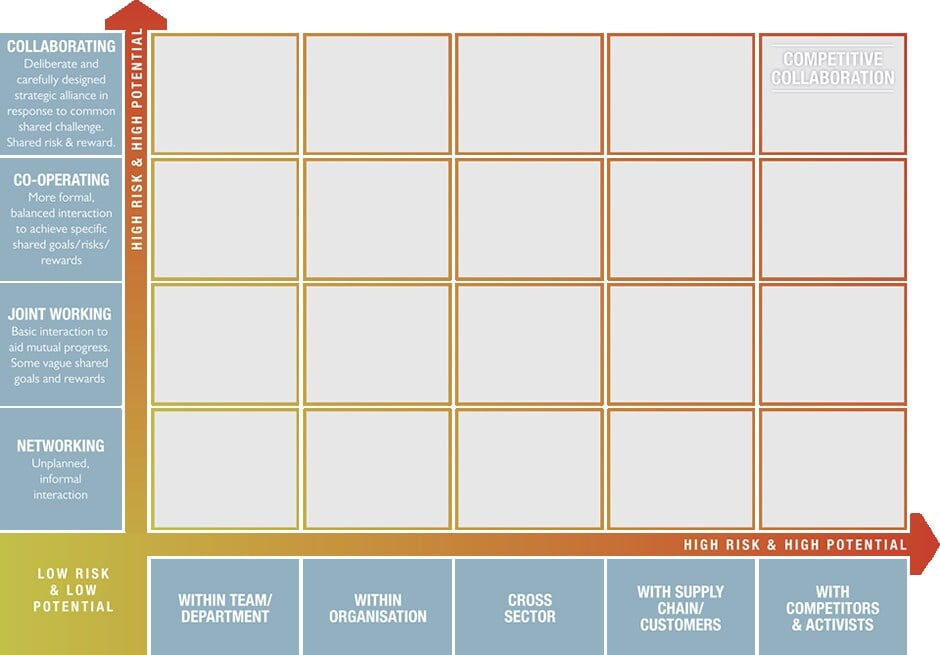Collaboration Part 1:
Is it really possible to collaborate with competitors?
Current economic conditions place huge pressure on organisations. We are required to constantly innovate ways to produce more with less. Our products, services and systems must flex quicker than ever before. Faced with such huge and persistent pressures, surely it’s much better not to act alone? In today’s world we all face increased connectivity and the transparency that this brings. Our customers, competitors and employees all have higher access than ever before to performance facts and figures. This environment makes for a perfect time to embark upon a new, networked approach and to consider the possibilities of outward collaboration.
In a break with tradition, businesses are increasingly beginning to co-operate with other organisations around them. Not only with those in their supply chain, but also, more daringly, with their direct competitors. Forging strategic alliances with those who share the same market is perhaps a bizarre concept and is certainly not without risk. Managed carefully, however, the benefits can be very attractive.
This new mode of working, which is so at odds with the defensive attitude of yesteryear, will no doubt pose new challenges - and opportunities - for HR and L&D. Traditional organisational structures and management methods may well prove too static and inflexible – and it will fall to HR to help people embrace collaboration as an operating principle. Exciting times lie ahead.
So, let’s look at the levels of collaboration
When it comes to collaboration, there any many different possibilities - characterised by the nature of the parties involved, and the depth of the relationships between them. I feel it is useful to split the opportunities into “inward collaboration” (taking place within the boundaries of the organisation) and “outward collaboration” (connecting with people and parties outside of the organisation).
Many of us are already succeeding in creating more inwardly collaborative workplaces – where employees engage in collegiate practices, working in project teams across different levels and functions. Those who have made significant steps to collaborate outwardly are, however, less common - though certainly on the increase.
The above chart is intended as a rough guide to illustrate varying degrees of collaborative relationships. It is non-numerical and not based on empirical research, but is hopefully a useful way of looking at collaboration in all its aspects.
Those relationships towards the bottom left hand corner of the grid are the more common, less risky ways of working with others. As you move up to the top right hand corner you enter into more daring collaborations, where the risks and potential benefits are both considerably greater. The top right hand corner represents competitive collaboration but could also represent collaborations with activists, or with those organisations/groups whose mission seems to be at complete cross-purposes with your own. We are increasingly seeing value in partnerships of this nature.
Take a moment to consider how many of the boxes on the grid you currently fulfil…and whether there are other boxes which you might benefit from operating in. Can you think of organisations in your network that you would benefit from collaborating with?
The Top Right Box – is it worth the risk?
It takes a lot of guts to embrace collaboration as an operating principle - especially when it comes to working with, rather than against, the competition. First let’s look at the benefits, and then see if we can find a way to manage the risks.
In a world of flux, collaborative organisations increase their chances of survival and success by being more responsive and quicker to adapt to change. Strategic alliances can build new support mechanisms and increase strength through pooled knowledge and resources.
Collaboration with those in the same industry can also bring technological advancement at a low cost. It may create entry points into untapped markets, or even the possibility of co-creating new markets. It can also be a fantastic way to strengthen core skills and to benchmark practises and performance. Innovation becomes more prevalent, with silos being broken down, releasing diversity and driving fresh ideas through new connections.
Strategic partnerships can also be a source of competitive advantage in themselves. Investing time and energy in creating a complex network of truly collaborative relationships can give you a huge competitive edge – and one that is incredibly difficult for others to buy, copy or steal.
But is it realistic to expect organisations to be involved in sustainable relationships which simultaneously contain elements of both cooperation and competition? Or are the compromises by both parties too sensitive to survive?
Managing the risks
When it comes to outward collaboration, the HR profession finds itself occupying a unique space. With its cross-functional view and responsibilities, HR is perfectly positioned to lead efforts to collaborate, both internally and externally. Collaboration brings a huge opportunity for HR to add real business value and affect the bottom line.
Involvement from HR at the early stages of collaboration is vital. When we at Impact consider making outward alliances, we initially look for organisations with complimentary skill sets, knowledge or experience. Our next step is to outline the potential benefit for each partner, assessing whether the aims are likely to be achieved without compromise to each party’s competitive position in the industry. A well-designed and facilitated process leads to agreement on levels of investment in time, money and resource and draws on the best from all parties.
We always remain flexible. Some of our collaborations are clearly articulated, with desired outcomes and an agreed plan of action. On other occasions they are more informal - a willingness to explore and discover together – yet still rooted in a clearly agreed framework of collaboration.
When it comes to competitive collaborations, however, it’s imperative to maintain clear strategic objectives for both partners. Although these sets of objectives may well differ, it is important to look at the dynamics between them, ensuring they are aligned rather than in any conflict. Often the less direct the competition the better, for example if research into a certain learning methodology is the aim of the partnership, it helps if each party intends to use the methodology for different purposes in different markets, thus reducing competitive conflicts.
Clarity is key. Knowledge sharing comes with risks – take a close look at who is involved in the relationship and make sure all are clear on what they can and can’t share. When imposing boundaries, however, remember that collaboration isn’t just a way to reduce research costs or access new technology. With strategic intervention from HR, it can also be a unique chance to learn from the other organisation. Take time to explore their culture, their leadership style, their ways of working together. Best practice from both organisations can be readily shared.
Managing relationships with this kind of care and attention will build the trust needed to bring partnership success - and the consequent achievement of a goal that would not have been attainable through working alone.
In my next blog post I'll look at the role of HR - how can HR professionals support successful collaboration?
In the meantime it'd be great to hear from you. Which boxes are you operating in? Can you see other opportunites for collaboration to add value? What's stopping you?
